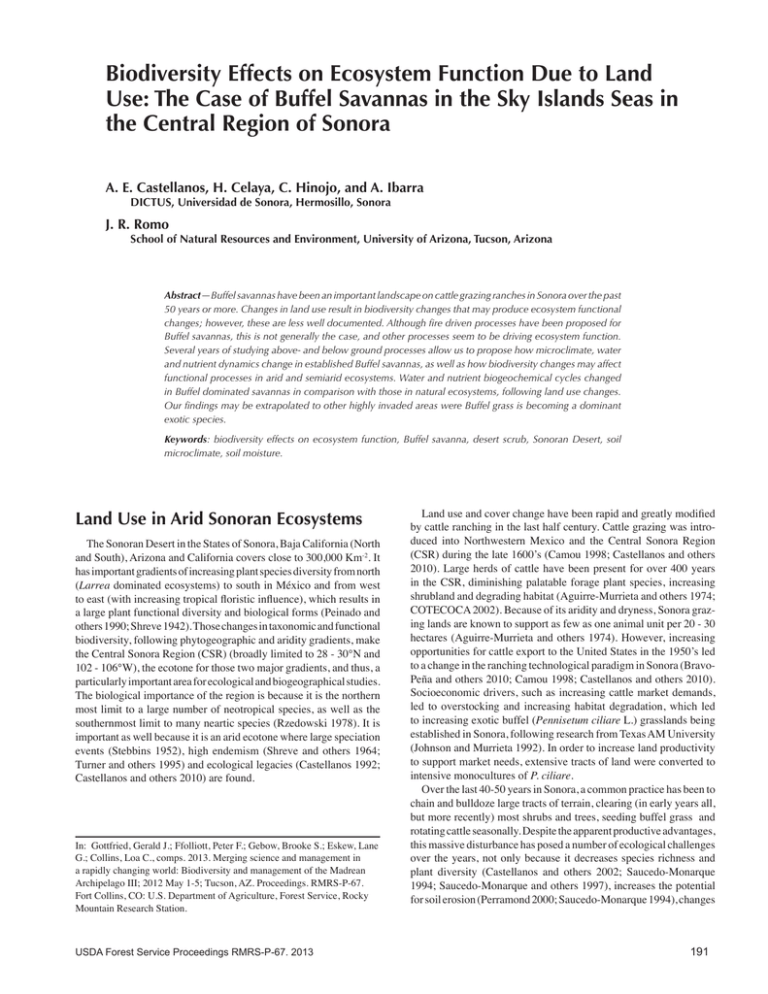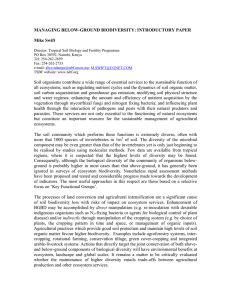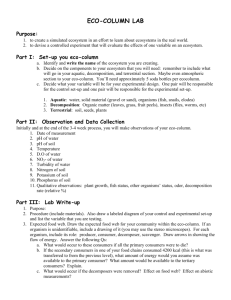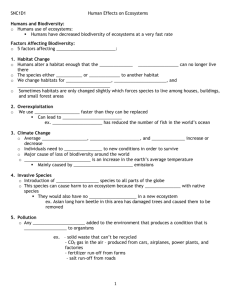Biodiversity Effects on Ecosystem Function Due to Land
advertisement

Biodiversity Effects on Ecosystem Function Due to Land Use: The Case of Buffel Savannas in the Sky Islands Seas in the Central Region of Sonora A. E. Castellanos, H. Celaya, C. Hinojo, and A. Ibarra DICTUS, Universidad de Sonora, Hermosillo, Sonora J. R. Romo School of Natural Resources and Environment, University of Arizona, Tucson, Arizona Abstract—Buffel savannas have been an important landscape on cattle grazing ranches in Sonora over the past 50 years or more. Changes in land use result in biodiversity changes that may produce ecosystem functional changes; however, these are less well documented. Although fire driven processes have been proposed for Buffel savannas, this is not generally the case, and other processes seem to be driving ecosystem function. Several years of studying above- and below ground processes allow us to propose how microclimate, water and nutrient dynamics change in established Buffel savannas, as well as how biodiversity changes may affect functional processes in arid and semiarid ecosystems. Water and nutrient biogeochemical cycles changed in Buffel dominated savannas in comparison with those in natural ecosystems, following land use changes. Our findings may be extrapolated to other highly invaded areas were Buffel grass is becoming a dominant exotic species. Keywords: biodiversity effects on ecosystem function, Buffel savanna, desert scrub, Sonoran Desert, soil microclimate, soil moisture. Land Use in Arid Sonoran Ecosystems The Sonoran Desert in the States of Sonora, Baja California (North and South), Arizona and California covers close to 300,000 Km-2. It has important gradients of increasing plant species diversity from north (Larrea dominated ecosystems) to south in México and from west to east (with increasing tropical floristic influence), which results in a large plant functional diversity and biological forms (Peinado and others 1990; Shreve 1942). Those changes in taxonomic and functional biodiversity, following phytogeographic and aridity gradients, make the Central Sonora Region (CSR) (broadly limited to 28 - 30°N and 102 - 106°W), the ecotone for those two major gradients, and thus, a particularly important area for ecological and biogeographical studies. The biological importance of the region is because it is the northern most limit to a large number of neotropical species, as well as the southernmost limit to many neartic species (Rzedowski 1978). It is important as well because it is an arid ecotone where large speciation events (Stebbins 1952), high endemism (Shreve and others 1964; Turner and others 1995) and ecological legacies (Castellanos 1992; Castellanos and others 2010) are found. In: Gottfried, Gerald J.; Ffolliott, Peter F.; Gebow, Brooke S.; Eskew, Lane G.; Collins, Loa C., comps. 2013. Merging science and management in a rapidly changing world: Biodiversity and management of the Madrean Archipelago III; 2012 May 1-5; Tucson, AZ. Proceedings. RMRS-P-67. Fort Collins, CO: U.S. Department of Agriculture, Forest Service, Rocky Mountain Research Station. USDA Forest Service Proceedings RMRS-P-67. 2013 Land use and cover change have been rapid and greatly modified by cattle ranching in the last half century. Cattle grazing was introduced into Northwestern Mexico and the Central Sonora Region (CSR) during the late 1600’s (Camou 1998; Castellanos and others 2010). Large herds of cattle have been present for over 400 years in the CSR, diminishing palatable forage plant species, increasing shrubland and degrading habitat (Aguirre-Murrieta and others 1974; COTECOCA 2002). Because of its aridity and dryness, Sonora grazing lands are known to support as few as one animal unit per 20 - 30 hectares (Aguirre-Murrieta and others 1974). However, increasing opportunities for cattle export to the United States in the 1950’s led to a change in the ranching technological paradigm in Sonora (BravoPeña and others 2010; Camou 1998; Castellanos and others 2010). Socioeconomic drivers, such as increasing cattle market demands, led to overstocking and increasing habitat degradation, which led to increasing exotic buffel (Pennisetum ciliare L.) grasslands being established in Sonora, following research from Texas AM University (Johnson and Murrieta 1992). In order to increase land productivity to support market needs, extensive tracts of land were converted to intensive monocultures of P. ciliare. Over the last 40-50 years in Sonora, a common practice has been to chain and bulldoze large tracts of terrain, clearing (in early years all, but more recently) most shrubs and trees, seeding buffel grass and rotating cattle seasonally. Despite the apparent productive advantages, this massive disturbance has posed a number of ecological challenges over the years, not only because it decreases species richness and plant diversity (Castellanos and others 2002; Saucedo-Monarque 1994; Saucedo-Monarque and others 1997), increases the potential for soil erosion (Perramond 2000; Saucedo-Monarque 1994), changes 191 Castellanos and others microclimatic soil conditions (Castellanos and others 2002); but also because it decreases important soil nitrogen (Castellanos and others 2002; Dalal and others 2005; Ibarra-Flores and others 1999), and changes nutrient dynamics (Castellanos and others 2010; CelayaMichel and others 2011; López 2007). Shrubland conversion to buffel savannas has changed biodiversity composition and ecosystem structure in such a way that no detailed knowledge exists on how those highly modified ecosystems will function, remain, change or affect different ecosystem processes, as well as biotic and trophic links. Buffel savannas dominated by a highly invasive grass species are an important part of the landscape in Sonora, but their ecological effects are unknown (Arriaga and others 2004). We believe that a better understanding of how introduced buffel savannas functions is needed and can help to understand the short and long-term ecological implications of this management policy, such as to understand some of the main causes for its spreading, as well as to help us establish better management practices to control its spreading into native adjacent ecosystems. Our approach also provides some badly needed basic knowledge on how Sonoran Desert and arid ecosystems function. Over the last 20 years we have studied paired sites in different arid ecosystems in the Central Sonora Region. Paired sites (buffel savannas and “native” vegetation cover) have been studied in order to answer some important questions in relation to the role of biodiversity in ecosystem function: • How are microclimate, soil moisture, and fertility dynamics modified in native compared to buffel savannas? • What are the changes in ecosystem nitrogen dynamics and how do they relate to changes in structure and species composition? • How are ecosystem degradation and resilience changed in a nearly monospecific-dominated ecosystem of buffel savannas? Biodiversity Change and Ecosystem Function Biodiversity is an important component of ecosystems and its qualitative and quantitative changes have been found to affect its function, an important consideration with increasing land cover use and change (Hooper and others 2005; Naeem and others 2002; Schulze and others 1994). A well- established paradigm relates biodiversity with net primary productivity (Tilman 1988; Tilman and others 2002; Tilman and others 1997; Wright and others 2006) and ecosystem stability (Tilman and others 2002; Tilman and others 2006). Even though buffel savannas have been proposed as a management alternative to increase land net primary productivity, some studies question that such a goal has been achieved. Using NDVI, as a proxy to measure vegetation productivity, has shown that plant productivity is much lower than proposed or expected in a range of conditions along a rainfall gradient (Bravo-Peña 2009; Romo 2006), in the Central Region of Sonora and a region north of it (Franklin and others 2006). Questions remain on how changes from natural ecosystems to buffel savannas affect biodiversity and biotic links at different levels, how and what ecosystem processes change, and how stability of these induced and simplified ecosystems is modified. Structural Changes in Plant Cover Plant removal for buffel grass establishment changed plant structure and cover (fig.1). While the herbaceous stratum is significantly increased by buffel cover in the savanna, total plant cover diminishes 192 Biodiversity Effects on Ecosystem Function Due to Land Use: . . . Figure 1—Changes in plant cover in Buffel savannas of different age of establishment. Old (≥30 yrs), Medium (10 - 30 yrs) and Recent (0 - 10 yrs). Natural is the predominant native vegetation at the site (modified from Romo (2006) and López (2007)). compared to native vegetation stands. It has been found (Romo 2006; Lopez 2007) that cover could further diminish after some 30-40 years of savanna establishment to about half compared to natural vegetation. We have proposed that a “green rush” effect drives cattle ranchers to adopt buffel savanna establishment (Bravo and others 2010a). The effect happens after the dry season and with the first summer monsoon rains. Once buffel has been established, because it is a fast growing herbaceous perennial species, it has the ability to immediately leaf-out after the very first rainfall pulses, producing an immediate “greeness” given that the whole savanna biomass is biologically, physically, and visually concentrated in only one vegetation stratum. Meanwhile, most neighboring plant species within native woody vegetation will green out later, resulting in large patches of brown and green because the greeness is distributed multi-dimensionally over the landscape. Soil Abiotic Controls Soil Temperature and Moisture Temperature and moisture are important drivers of ecosystem processes in the soil. Mean annual soil temperatures at 10 cm were not different at different sites of buffel cover, but their temperature dynamics were different (fig. 2). As expected, maximum and minimum soil temperatures were found in bare areas (ISN and ISB), which showed the largest soil temperature fluctuations in a given time. Vegetation cover damps soil temperature in fall and winter months and during most of the year its coefficient of variation was the lowest. Higher minimum soil temperatures were found under O. tesota trees and under buffel grass. Mean soil temperatures were higher under trees and lowest in the savanna because of large temperature fluctuations during the day. Buffel microsites had the lowest soil maximum temperatures during fall and winter but not in summer when PFB had about 15 - 20 °C lower temperatures compared to similar microsites in natural vegetation (PFN). Largest daily and seasonal variations in soil temperatures in bare and buffel areas may have important implications to establishment of successional native species (Morales-Romero and others 2008; Saucedo-Monarque 1994). Soil maximum (Tsmax) and average (Taav) temperatures as well as minimum (Tamin) and average (Taav) air temperatures were significantly related to soil respiration. Highest significances were found between soil respiration and Tsmax. Soil respiration was also directly related to volumetric soil moisture at all times during the USDA Forest Service Proceedings RMRS-P-67. 2013 Biodiversity Effects on Ecosystem Function Due to Land Use: . . . Castellanos and others Figure 2—Mean soil temperature at different microsites during the year. PFN = under ironwood (O. tesota) trees in natural vegetation, PFB = similar but within the Buffel savanna; ISN = interspace (bare areas between trees, shrubs or herbaceous perennials) in natural vegetation, ISB = similar but within Buffel savannas; BB = under the canopy of Buffel grass. year, although this relationship decreased with depth to 50 cm and deeper. Soil moisture changed with site (table 1; fig. 3), year, and time of the year. Soil moisture in the buffel savanna was significantly lower because lower soil moisture in the interspaces and under O. tesota trees, compared to similar habitats in natural ecosystems. Soil moisture under ironwood in the savanna (PFB) had the lowest mean soil moisture (2.60 ± 2.2 g H2O g-1 soil p<0.01) but not significantly lower than the one found for the same microsite in natural vegetation (PFN, 4.15 ± 4.9 g H2O g-1 soil). Although not expected, because of late summer and early fall rainfalls during the last 2 years, soil moisture was higher at depths below 100 cm in sites with increasing aboveground leaf cover, including fewer than 100 cm in buffel grass. This is below depths of usable soil moisture (close to 60 - 70 cm in buffel), and depths of 130 - 150 cm below O. tesota canopies. Soil Biotic Interactions Termite Activity Termite diversity was affected by changes in plant cover and structure in the natural vegetation and buffel savanna. In both ecosystems, termite richness did not change and the same six species were found in both ecosystems throughout the year (fig. 4). Of the species found, Gnathamitermes perplexus (41%) and Heterotermes aureus (33%) were the two most frequent termite species. Other species were Amitermes spp, Hoplotermes spp and Tenuirostritermes spp as well as an unidentified Amitermitinae species. Small numbers of plots yielded small numbers of termite species. Expected termite richness ("Mao Tau" computed by the EstimateS® program using pooled plot data) was almost 25% higher for natural systems (8 spp) compared with buffel savanna (Sobs in fig. 4). "Chao2," another EstimateS richness output that assumes a different distribution of sampling error, gave similar results, with highest values for termite species richness during September on natural sites. During winter months (not shown on fig. 4), richness was lowest in natural systems. Chao2 curves confirm that the sampling effort on study sites was appropriate (fig. 4). Termite presence, seasonal activity, frequencies and trophic substrates did change between natural and buffel savanna ecosystems. Seasonal presence of termite species changed in both ecosystems. buffel savannas termites were most active during autumn-winter seasons, while major seasonal activity in natural ecosystems occurred at the end of summer-early fall season under O. tesota trees. Changes were also found in the interspaces—bare zones between species—with most important termite activity at the end of winter-spring seasons, while under buffel in the Savanna, activity periods were at the end of summer rainy season and during winter months. In bare unprotected zones, diversity was lower and major activity was found during spring. An important finding was that Gnathamitermes perplexus, the most common species in the buffel savanna, was found foraging mostly Table 1—Changes in water availability at different depths in native vegetation and Buffel savanna sites. Volumetric water percentage obtained with TRIME® access tubes. Natural SABANA Mean±s.e. Mean±s.e. N F P 0 to 50 cm 3.38±0.28a 33.25±.25a 30 0.1251 0.072* 0 to 100 cm 8.22±0.52a 5.78±.47b 30 12.140 0.0007** 0 to 150 cm 11.56±0.75a 7.65±.68b 30 14.8735 0.0002** USDA Forest Service Proceedings RMRS-P-67. 2013 193 Castellanos and others Biodiversity Effects on Ecosystem Function Due to Land Use: . . . Figure 3—Changes in available soil moisture (amount of water in cm, in a profile), for different microsites in natural and Buffel savanna sites. Figure 4—Expected termite richness in natural and Buffel savanna sites using Estimates®. 194 USDA Forest Service Proceedings RMRS-P-67. 2013 Biodiversity Effects on Ecosystem Function Due to Land Use: . . . on this grass species, behaving as an opportunistic species, changing its trophic substrate to the more abundant buffel litter. In a different study under Sonoran Desert conditions in Arizona, higher activity of Gnathamitermes perplexus was found in the range of 9 to 49 °C, while Heterotermes aureus, had a slightly lower, 7 to 47 °C, range (table 2; Haverty 2001). Discussion Chambers and others (2007) mention the hypothesis of fluctuating resources and say that invasibility is related to the availability of resources. In particular, invasibility increases if increasing resources are not utilized by natives. The availability of resources to buffel grass will be related to (a) an increase in supply reliability or (b) a decrease in uptake by natives. Many studies relate increasesd availability of nitrogen with increased invasibility. Acknowledgments We thank CONACYT for its support to project (CB66,,,,) and as scholarships (A.I., C.H., H.C., J.R.R.) during these studies. We thank Mr. Luis Sierra for allowing us to perform our research on his property. References Aguirre-Murrieta R et al. (1974) Coeficientes de agostadero para el estado de Sonora. In. COTECOCA - SAG, México, p 133. Arriaga L et al. (2004) Potential ecological distribution of alien invasive species and risk assessment: A case study for buffel grass in arid regions of Mexico. Conservation Biology 18:1504-1514. Bravo-Peña LC (2009) Ganadería y cambios de la cubierta vegetal en la Región Central de Sonora. Impactos sobre el paisaje y vulnerabilidad de los productores pecuarios en el contexto del cambio climático. In: Desarrollo Regional. CIAD, A. C., Hermosillo. Bravo-Peña LC et al. (2010) Políticas rurales y pérdida de cobertura vegetal. Elementos para reformular instrumentos de fomento agropecuario relacionados con la apertura de praderas ganaderas. Región y Sociedad 22:3-35 Camou E (1998) De Rancheros, Poquiteros, Orejanos y Criollos: Los Productores Ganaderos de Sonora y el Mercado Internacional. El Colegio de Michoacán y CIAD, A.C., Zamora, Mich. Castellanos AE (1992) Ecología, utilización y conservación de las comunidades vegetales en el estado de Sonora. Un análisis. In: Moreno JL (ed) Los Recursos Naturales del Estado de Sonora. SIUE - El Colegio de Sonora, Hermosillo, pp 25-37. USDA Forest Service Proceedings RMRS-P-67. 2013 Castellanos and others Castellanos AE et al. (2010) Impactos Ecologicos por el Uso del Terreno en el Funcionamiento de Ecosistemas Aridos Semi-Aridos de Sonora. In: Molina-Freaner F, Van Devender TR (eds) Diversidad Biologica del Estado de Sonora. CONABIO - UNAM., México, D. F., pp 157 - 186. Castellanos AE et al. (2002) Drought - tolerant exotic buffel - grass and desertification. In: Tellman B (ed) Weeds Across Borders. Arizona-Sonora Desert Museum, Tucson, AZ. Celaya-Michel H et al. (2011) Mineralización de nitrógeno en el suelo de zonas áridas y semiáridas. Terra Latinoamericana 29:343-356. Chambers. KC et al. 2007. What makes Great Basin sagebrush ecosystems invasible by Bromus tectorum. Ecological Monographs 77: 117-145. COTECOCA (2002) Diagnóstico de los agostaderos del Estado de Sonora. In. COTECOCA, Hermosillo, Sonora, p 52. Dalal RC et al. (2005) Total soil carbon and nitrogen and their pools following Mulga (Acacia aneura) clearing for pasture development and cropping 1. Total and labile carbon. Australian Journal of Soil Research 43:13-20. Franklin KA et al. (2006) buffelgrass (Pennisetum ciliare) land conversion and productivity in the plains of Sonora, Mexico. Biological Conservation 127:62 - 71. Haverty MI (2001) The role of toilet paper in studies of desert subterranean termites (Isoptera) in Arizona, USA: A substrate for nondestructive observations of foraging activity. Sociobiology 37:245-252. Hooper DU et al. (2005) Effects of biodiversity on ecosystem functioning: a consensus of current knowledge. Ecological Monographs 75:3 - 35. Ibarra-Flores F et al. (1999) Soil physicochemical changes following buffelgrass establishment in Mexico. Arid soil research and rehabilitation 13:39 - 52. López D (2007) Changes in carbon and nitrogen with buffelgrass (Pennisetum ciliare) introduction in Sonora, Mexico. In: Biological Sciences. Northern Arizona University, Flagstaff, AZ, p 67. Morales-Romero D et al. (2008) Influence of buffelgrass pasture conversion on the regeneration and reproduction of the columnar cactus, Pachycereus pecten-aboriginum, in northwestern Mexico. Journal of Arid Environments 72:228-237. Naeem S et al. (2002) Biodiversity and ecosystem functioning: The emergence of a synthetic ecological framework. In: Loreau M, Naeem S, Inchausti P (eds) Biodiversity and Ecosystem Functioning. Synthesis and perspectives. Oxford University Press, Oxford, pp 33-11. Peinado M et al. (1990) Introducción al conocimiento fito-topográfico de Baja California (México). Studia Botanica 9:25-39. Perramond E (2000) A preliminary analysis of soil erosion and buffelgrass in Sonora, Mexico. Yearbook, Conference of Latin American Geographers 26:131-138. Romo JR (2006) Conservation and the changing pattern of land cover and land use in central Sonora, Mexico. In: Environmental Sciences and Policy. Northern Arizona University, Flagstaff, AZ, p 103. Rzedowski J (1978) Tipos de Vegetación de México. LIMUSA, México. Saucedo-Monarque E (1994) La Introducción de Zacate buffel (Cenchrus ciliaris L) en el Estado de Sonora, un Factor de Modificación de la Veg- 195 Castellanos and others etación. In: Instituto de Recursos Naturales. Colegio de Postgraduados, Montecillo, México, p 129. Saucedo-Monarque E et al. (1997) La riqueza, una variable de respuesta de la vegetación a la introducción del zacate buffel. AgroCiencia 31:83-90 Schulze ED et al. (eds) (1994) Biodiversity and Ecosystem Function. SpringerVerlag, Berlin. Shreve F (1942) The desert vegetation of North America. The Botanical Review 8:195-246. Shreve F et al. (1964) Vegetation and flora of the Sonoran Desert. Stanford University Press, Stanford. Stebbins GL (1952) Aridity as a stimulus to plant evolution. The American Naturalist 86:33-44. Tilman D (1988) Plant Strategies and the dynamics and structure of plant communities. Princeton University Press, New Jersey. Biodiversity Effects on Ecosystem Function Due to Land Use: . . . Tilman D et al. (2002) Plant diversity and composition: effects on productivity and nutrient dynamics of experimental grasslands. In: Loreau M, Naeem S, Inchausti P (eds) Biodiversity and Ecosystem Funtioning. Synthesis and perspectives. Oxford University Press, Oxford, pp 21 - 35. Tilman D et al. (1997) Plant diversity and ecosystem productivity: Theoretical considerations. Proceedings of the National Academy of Siciences 94:1857 - 1861 Tilman D et al. (2006) Biodiversity and ecosystem stability in a decade-long grassland experiment. Nature 441:629-632 Turner RM et al. (1995) Sonoran Desert Plants: An Ecological Atlas. The University of Arizona Press, Tucson Wright JP et al. (2006) Conventional functional classification schemes underestimate the relationship with ecosystem functioning. Ecology Letters 9:111 – 120 The content of this paper reflects the views of the authors, who are responsible for the facts and accuracy of the information presented herein. 196 USDA Forest Service Proceedings RMRS-P-67. 2013







